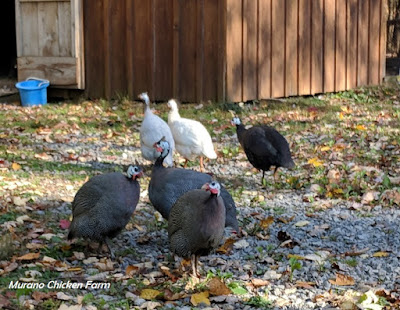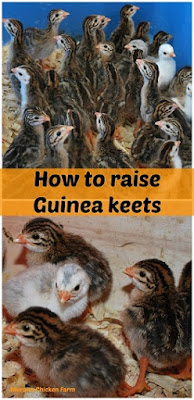Luckily raising guinea fowl keets is almost the same as raising chicks so if you've raised chicks before, keets will be just as easy.
How to raise guinea fowl keets
The brooder set up that you'll need for guineas is the same as it is for chicks. You can see my recommendations here in Brooder Basics. I like to raise guinea keets in their own brooder separate from regular chicks.
keets are so small, they can easily be trampled or squashed by bigger chicks. The only illnesses I have seen in guinea keets is spraddle leg and pasty butt so they are pretty hardy for as small as they are.
Brooder temperature for guinea keets
While guinea fowl keets have most of the same needs as chicks, they are a bit more delicate. You have to be very careful that guinea keets do not get cold because once they get cold they can die very quickly. As with chicks, you'll start them out at 95 degrees, however they will stay at this temperature for the first two weeks. After two weeks you'll drop the temperature 5 degrees each week until they're fully feathered.
When guinea keets are a few weeks old their first set of feathers will come in. For pearl guinea fowl, these feathers will be a brown and white marbled pattern. Their wings will grow faster than the rest of the bird and they will hang down very awkwardly for a few weeks. By 2 months old these feathers have fallen out and been replaced by the spotted gray feathers they are so well known for.
Guinea keets can go outside at about 8 weeks old. At this point they should be off the heat light and ready to live in the coop. Train your guineas to go in the coop each night with this advice from Guinea Fowl International.
Feeding Guinea fowl keets
I feed my guinea fowl keets game bird starter. Game bird starter has a higher protein level then chick starter and guinea keets grow faster than chicks so they need the extra protein. I have raised keets on regular chick starter and they haven't had any problems per se, they do much better on gamebird feed though.
If you cannot buy high protein feed in your feed store, add extra protein to their diet daily. Scrambled eggs and dried mealworms are some of the easiest forms of protein for tine keets. Make sure to offer grit when supplementing their diet.
Once they move from the brooder to the coop, I feed them the same layer pellets that the chickens eat. Offer oyster shell or crushed eggshells as a calcium supplement.
Telling male and female guinea fowl apart
When trying to tell the male keets from the female keets there is only one method that is foolproof and that is the sound test. The female makes the different call than the male does however she also makes the male call. I explain it all (with video) in this post Sexing Guinea Fowl By Sound.
Unfortunately, they don't start to make these calls till they're about 2 months old.
Unlike chickens, guineas tend to pair up to mate or sometimes they'll form a trio. This being the case you'll need closer to a 2 to 1 female to male ratio....which is good because keets are only sold as straight run since they can't be sexed at hatch.
Occasionally, if your guineas were hatched early in the spring the hens will start laying that same year. More likely though, they will wait till the next spring to start laying eggs. Guinea hens are very seasonal layers and they do not lay in winter at all.
If you have any other questions about raising guinea fowl you might find the answers here: Guinea Fowl 101 or feel free to leave a question down below and I will answer it as best I can!
~L
Want information on raising chickens sent right to your email weekly? Click right here to join my list and get new posts sent directly to you the day they're published ... plus, you'll also get the free download '25 Ways to save money raising chickens'.





Will you be selling guinea keets this year?
ReplyDeleteYes, I will. I should have some starting next week.
DeleteLisa
This is very interesting. I grew up with raising chicken but we never had quineas. So i didn't know a lot about them except that they are good watch dogs. Thanks for sharing. Congratulations on being featured on Homestead blog hop. Have a healthy, happy & blessed day!
ReplyDeleteIs it too late to get some keets? We have a severe grasshopper problem. And are they able to get up into tress to get away from dogs?
ReplyDeleteNope, you can still get keets! In fact, it's often easier in summer as the heat outside makes the heatlamp not as important after about 3 weeks. Mine get in the trees all the time, but they can't fly that high till about 8 weeks.
Delete~L
Hello I'm new and so far im enjoying your webpage! I'm raising 16 keets that are going on their 3rd week of life and feel so lost. I do have a question as we are currently October 16 and winter is fast approaching. We've built a 5'x 3' brooder (currently in my home) with a perch they love roosting on under a low level heat lamp. I am trying to follow the reducing 5 degrees each week to ween them off so they can eventually have the brooder brought out to the barn / coop area. My question is....
ReplyDelete1) Ottawa Canada gets VERY cold 20-40 cel is common for many months. I'm trying to determine how to winterize the coop that is about 10x 8' so they don't freeze. The coop is located inside a 30' Barn that has open ventelation ALL around the large barn which on one side drafts into the coop I think I should close that up so there is no direct air coming in from the the side of the barn into the coop. Right now the coop roof is mesh wire only & then opens up to a vaulted tin roof of the barn. I was going to add wood to the ceiling of the coop to block heat excaping. I'm not sure how to properly "VENT" this room so there are no drafts yet there is also air flow so it doesnt have moisture build up. Or maybe it's so big for 16 guinesa i'm over thinking this...
(Would be easir if i could send you photos lol)
Also How should I transition them properly from my house to the barn without it being too cold for them??? any thoughts on that? Essentally i feel lost and im terrified this winter will kill them.
Hi! Yes, you should close up drafts that blow directly on the guineas while in the coop. All ventilation holes should be higher than roost level so the guinea keets don't have air blowing on them, but that moisture can escape from roof level. Pictures of the guinea coop set up will definitely help! Send to: Lisa@muranochickenfarm.com
DeleteTo transition guinea fowl keets, keep lowering your heat week by week. After they are fully feathered (about 6 weeks) start turning the heat off during the day. As long as the guinea keets are not huddled up and cold looking they are fine. Once they're used to this, turn off the heat at night too. When you move the guinea keets out to the coop they may need a little bit of heat for the first few weeks if the temperature difference is drastic. Good luck with them and feel free to email me pictures!
Lisa
Hi I live in Northern Thailand and we have 15 Guinea Fowl this year we had eggs which the parents didn’t sit on so we hatched them in a incubator a couple of days ago.
ReplyDeleteWe can only obtain chicken raising mix here, can you advise what we can add to give the Keets more protein
Thanks
I hatch almost all my guineas eggs in the incubator...they're just not great mamas. You can give them cooked eggs, mealworms or other insects to raise the protein level in their feed.
DeleteLisa
Many thanks Lisa much appreciated
DeleteSteps
Stephen and Orathai
Hi Lisa thanks for your previous advice regarding adding protein the little guys and gals are thriving and real characters one escaped and I didn’t realize they could fly so well at such a young age anyhow like Marys little lamb he/she came back anxious to join the family
ReplyDeleteI do have another question if you could help me we have since hatched three more batches but out of each batch two or three seem to have a problem standing properly almost like a form of spasticity in humans but their feet and legs appear normal
Have you ever encountered this or is it some form of genetic deformity
Many thanks
Orathai